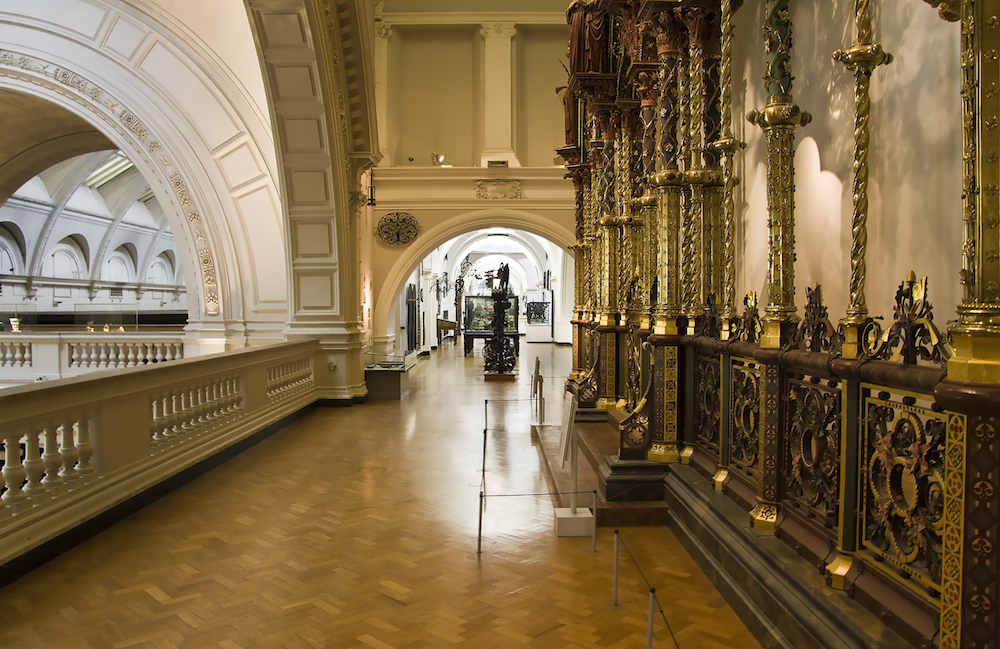History of the Victoria & Albert Museum in London
The Victoria & Albert Museum is one of the largest and best museums in the world. Often referred to as the V&A, it contains art from all around the world spanning thousands of years. Many of its collections represent the most comprehensive collections of their kind in the world, and the museum itself is a must-see for anyone visiting London.

History of the Victoria & Albert Museum
The first few years of the Victoria & Albert Museum history were especially eventful. It began life in 1851 as the Museum of Manufactures. Henry Cole was its first director, and its collection covered both applied art and science at this time.
In 1855, the museum’s collections were transferred to its current site. It was then renamed the South Kensington Museum, and Queen Victoria officially opened it in 1857. Late-night openings were first introduced during this time, which was made possible with gaslighting.
The science collections were gradually removed from the main museum over the next few decades, and in 1893 the Science Museum officially became its own entity.
Interestingly enough, the Victoria & Albert Museum didn’t receive its current name until 1899. This happened during the laying of the foundation stone of the Aston Webb building. This ceremony happened to be the last public appearance of Queen Victoria.
Victoria & Albert Museum history during World War II was another interesting time. During the war, most of the museum’s collection was sent to various hidden locations to keep it safe. Some of the galleries were also used as a school for children who evacuated from Gibraltar.
The Britain Can Make It exhibition was held in 1946 after the war ended. This exhibition attracted an astounding million and a half visitors. Almost the entire collection had returned to the museum by 1948.
The museum hosted its first rock concert in 1973. This featured a combined concert/lecture by the folk-rock band Gryphon. Finally, a major renovation project was launched in 2001. This was done to make sure the museum is able to meet modern standards. The Duchess of Cambridge became the museum’s first royal patron in 2018.

14 Permanent Collections at the Victoria & Albert Museum
The permanent collections at the Victoria & Albert Museum consist of over 2.27 million objects spanning 5,000 years. Because the inventory is so fast, not all items are on display. As the collection is quite vast, we recommend a guided tour as part of our London Highlights Tour. That said, the main collections at the V&A include:
Architecture Collection
Location: Rooms 127 – 128a
The Architecture collection at the Victoria & Albert Museum is considered the most comprehensive architectural resource in the world. Co-curated by the Royal Institute of British Architects, it contains various models, photographs, sketchbooks and original drawings from major British and international architects starting in the 15th century to the present day.
Asia Collections
Location: Room 41 (South Asia) and Rooms 44 & 47e, The T.T. Tsui Gallery (China)
There over 160,000 objects in the V&A’s Asia collection making it one of the largest in the world. The entire continent of Asia is represented, and it has one of the most comprehensive collections of Chinese art in particular. The South Asia collection is also robust with over 10,000 textiles and 6,000 painting from Afghanistan, Bangladesh, India, Pakistan, Nepal, and Sri Lanka.
Books Collection
Location: National Art Library Reading Rooms
The Books Collection at the Victoria & Albert Museum is located in the National Art Library. A public library, it has over 750,000 books, photographs, drawings, paintings, and prints, making it one of the largest museums in the world dedicated to the study of fine arts.
British Galleries
Location: Found throughout the Museum
The British Galleries at the V&A contains over 4,000 items from between 1500 to 1900. Some of its notable works include Henry VIII’s writing desk and the Great Bed of Ware.
Cast Courts
Location: Room 46a – 46b
Opened in 1783, the Cast Courts at the Victoria & Albert Museum has hundreds of plaster casts of various sculptures, friezes, and tombs. These include life-sized replicas of Michelangelo’s David, Trajan’s Column, and Ghiberti’s Gates of Paradise.

Ceramics & Glass Collections
Location: Rooms 136 – 146 and Room 129, The Märit Rausing Gallery
The Ceramics & Glass Collection at the V&A has over 80,000 objects with every continent in the world being represented. Considered the most comprehensive in the world, its glass collection, in particular, spans 4,000 years of glassmaking.
Fashion Collection
Location: Room 40
The Fashion Collection at the Victoria & Albert Museum is the most comprehensive costume collections in Britain. Spanning five centuries, it has over 4,000 different costumes including some of the rarest gowns, dresses and post-war couture.
Furniture Collection
Location: Rooms 133 – 135, The Dr Susan Weber Gallery
The Furniture Collection at the V&A is predominantly British. However, it also contains items from American and Europe that date back to the Middle Ages. The oldest piece of furniture in the collection is an Egyptian chair leg from 200-395 AD.
Jewellery Collection
Location: Rooms 91 – 93, The William and Judith Bollinger Gallery
The Jewelry Collection at the Victoria & Albert Museum is one of the most comprehensive in the world. It has over 3,000 items, some of which date back to Ancient Egypt. It includes jewellery worn by historical figures such as Catherine the Great and Marie Antoinette.
Metalwork Collection
Location: Found throughout the Museum
Metalwork at V&A is showcased across several collections including Art Deco, Arts & Crafts, Art Noveau, China, Islamic Middle East, Korea and Japan. It contains over 45,000 items, 10,000 of which are made from either silver or gold. The collection includes the Gloucester Candlestick, the Becket Casket, and the Burghley Nef.

Paintings Collection
Location: Rooms 81 & 82, The Edwin and Susan Davies Galleries
An original part of the Museum of Ornamental Art later renamed the Victoria & Albert Museum; there are over 8,500 paintings (oil, watercolours, pastels) and 2,000 miniatures in its paintings collection. A few of its more famous works include Raphael Cartoons and significant works by J. M. W. Turner and John Constable.
Photography Collection
Location: Photography Centre, Rooms 99 – 101
The photography collection at the V&A collection contains over 800,000 photographs dating from 1839 to the present. The collection is extensive as the original director of the museum, Henry Cole, was an amateur photographer and a great supporter of the art of photography.
Sculpture Collection
Location: Rooms 21 – 24, The Dorothy and Michael Hintze Galleries
The Sculpture Collection at the Victoria & Albert Museum has more 26,000 objects and includes sculptures from artists such as Michaelangelo, Donatello, and Antonio Canova. The sculptures are made in a range of materials including alabaster, amber, bronze, marble, terracotta, lapis and shell, wood, and wax.
Textiles Collection
Location: Found throughout the Museum
There are over 75,000 objections in the V&A’s Textile Collection. Most of these items are from western Europe, and some date back to the 1st century AD.
Visiting the Victoria & Albert Museum
The Victoria & Albert Museum is located at Cromwell Road, London, SW7 2RL. The nearest London Underground Station is South Kensington on the District, Piccadilly and Circle lines. From South Kensington, walking to the V&A takes about 5-minutes. Gloucester Road and Knightsbridge are also within walking distance.











